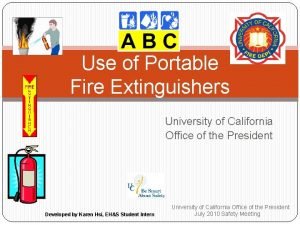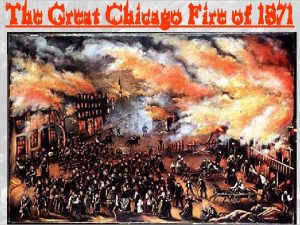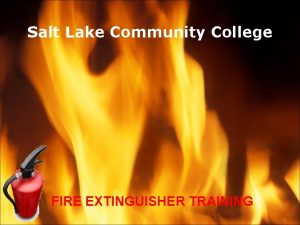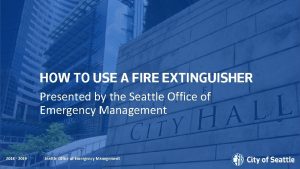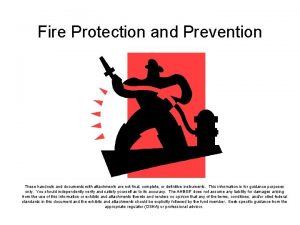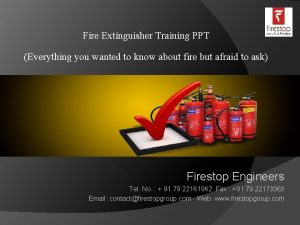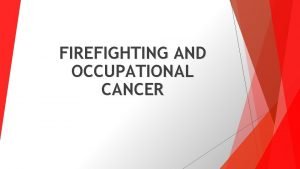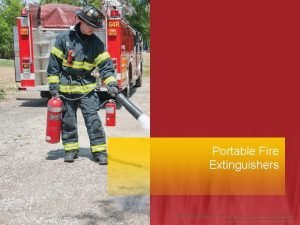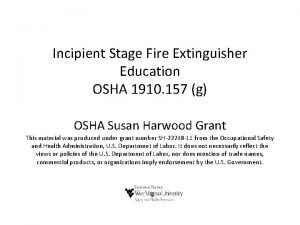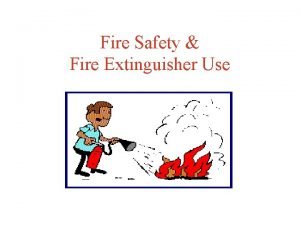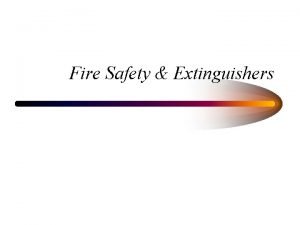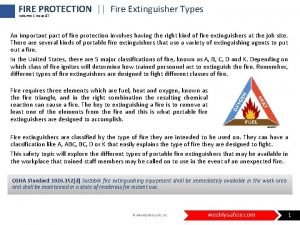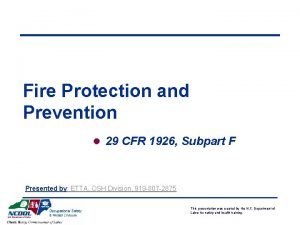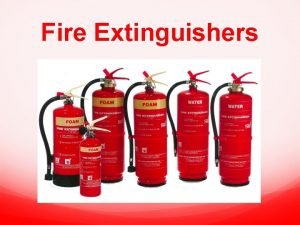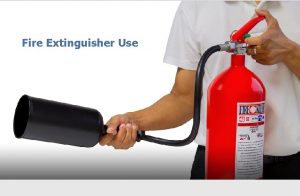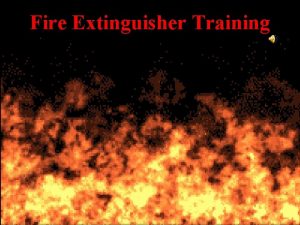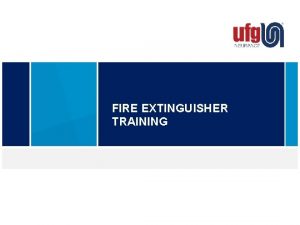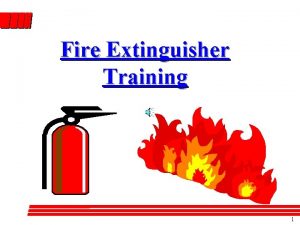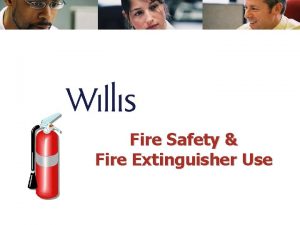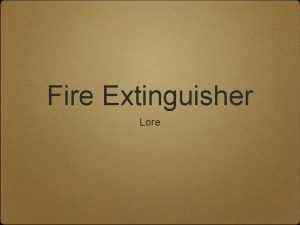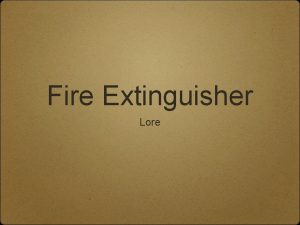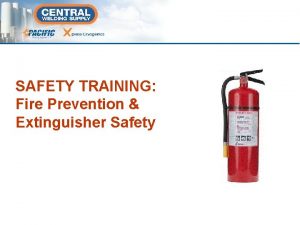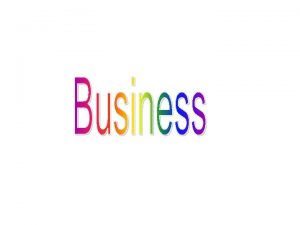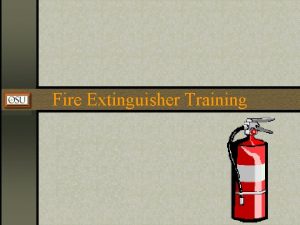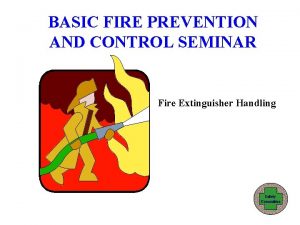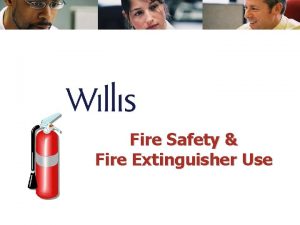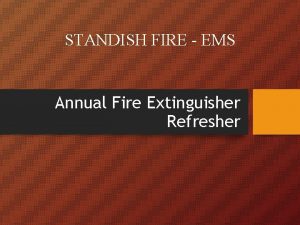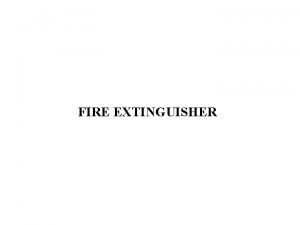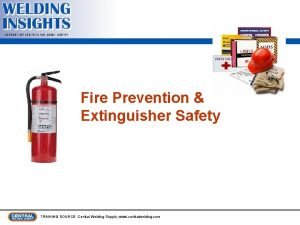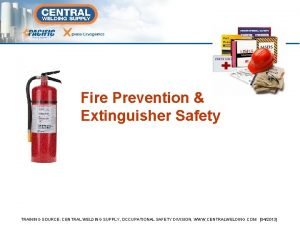Jay Industries Inc Fire Extinguisher Training Fire Prevention



















- Slides: 19

Jay Industries, Inc. Fire Extinguisher Training Fire Prevention Plan EHS Department November 2015

Fire Triangle plus One Four elements that must be present for a fire to exist. 1. Oxygen for combustion; 2. Heat to reach ignition temperature; 3. Fuel to support the combustion; 4. A Chemical Reaction between the other three elements.


Fire Prevention The concept of Fire Prevention is based upon keeping the FOUR elements separate. Take one side away of the triangle and the fire will go out.

Types of Fires Ordinary combustibles such as wood, paper, cloth and plastics; solids that are not metal. Class A Flammable liquids such as gasoline, petroleum based oil, paint, and solvents. Also, flammable gases such as propane and butane. Class B Energized Electrical equipment, such as motors, transformers and appliances. If there is no power, Class C becomes one of the other classes. Energized means it is plugged into an electrical source. Class C Combustible metals such as postassium, sodium, aluminum and magnesium Class D Class K fats Cooking oils, grease, animal and vegetable

Types of Fire Extinguishers at Jay Industries • ABC=Regular Fire • CO 2=Machinery/Electrical • Purple K=Flammable Liquids • Halotron=Engergized Electrical Equipment

Use of Fire Extinguishers • Some types of fire extinguishers can be used on more than one class of fire. • Other fire extinguishers have warnings about their use. • It would be not effective or dangerous for the operator to use the wrong fire extinguisher.

Only fight a fire if: The fire is small and contained You are safe from toxic smoke You have a means of escape Your instincts tell you it’s ok

When to use an Extinguisher? Use a fire extinguisher in the early stages of a fire. Once the fire starts to grow or spread, it is best to evacuate the building, closing doors or windows behind you.

Fire Extinguishers in your Plant Know the locations and types of Fire Extinguishers in your work area BEFORE you have to use one. Take time to read the operating instructions and warnings on the fire extinguisher label. Fire extinguishers can be heavy, so it is a good idea to pick up and hold a fire extinguisher so that you know the weight and feel.

Triple A-A-A Rule Activate the building alarm or call 9 -1 -1. Or have someone do it for you. Assist any persons in immediate danger, or those incapable, to exit the building, without risking your own safety. Or have someone do it for you. Attempt to extinguish the fire.

P-A-S-S P=Pull the pin A=Aim the nozzle or hose at base of the fire from recommended safe distance S=Squeeze the operating lever to discharge the fire extinguisher contents S=Sweep the nozzle or hose from side to side from a safe distance. Move around the fire as it diminished. Watch the are in case it re-ignites or spreads

Emergency Action Plan Your building has an emergency action plan. You should read it and know it. It explains fire evacuations.

Fire Prevention Plan Know the fire prevention plan Follow its rules Inform your supervisor if you see a potential fire hazard

Potential Fire Hazards & Solutions Flammables-proper storage and containers Trash and Debris-Good housekeeping Smoking-only in designated areas Welding-follow work orders Machinery hazards- Proper cleaning and maintenance

Monthly Fire Extinguisher Inspection -Is the extinguisher in the correct location? -Is it visible and properly marked? -Is it accessible and not blocked by items? -Is the pressure indicator correct? -Is it hung up correctly?

Fire Extinguisher Maintenance Fire extinguishers are serviced annually They are checked monthly for pressure and condition They are taken out of service after a certain age

Used Fire Extinguishers If you use a fire extinguisher, take it to the designated location in your plant Obtain another fire extinguisher from the designated location Supervisors should notify EHS of any fire extinguisher use.

Questions? Comments? Thank you and stay safe on the job!
 Primary prevention secondary prevention tertiary prevention
Primary prevention secondary prevention tertiary prevention Cal osha fire extinguisher training
Cal osha fire extinguisher training Fire extinguisher training chicago
Fire extinguisher training chicago Fire extinguisher training
Fire extinguisher training Anatomy of fire extinguisher
Anatomy of fire extinguisher Fire extinguisher training handout
Fire extinguisher training handout Fire training ppt
Fire training ppt Alex forrest winnipeg
Alex forrest winnipeg Fire extinguisher training quiz
Fire extinguisher training quiz Fire hose reel signage standards
Fire hose reel signage standards Bulk gaining industry
Bulk gaining industry Pass acronym
Pass acronym 1910 fire extinguisher
1910 fire extinguisher Pull the pin
Pull the pin Fire extinguisher introduction
Fire extinguisher introduction Class of fire
Class of fire Osha 1926 fire extinguisher
Osha 1926 fire extinguisher Pass method fire
Pass method fire Fire extinguisher types
Fire extinguisher types Fire triangle
Fire triangle

